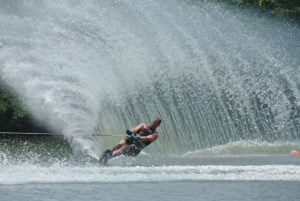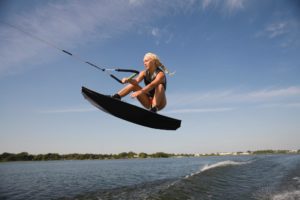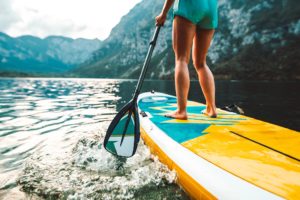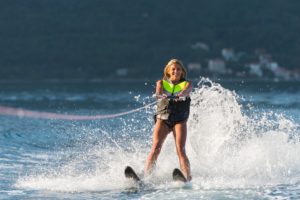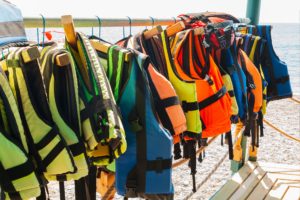Hi. My name is Mike Ferraro and I’m going to talk to you today about Ronix Vault Wakeboard. Some of the things that are really interesting, and that I really like about designing wakeboards, are there’s such a wide range of users. One of the big challenges that I always pride myself in is finding features of a board or blends of features that will allow a guy’s first time or a girl’s first time, or helping a guy do a 1260. The needs of a pro rider are totally different than the needs of a rider trying to determine their riding style. Really to force someone who really hasn’t determined their riding style yet to ride a board that is designed for that riding style isn’t really fair. Coming up with a design that will allow you to determine you riding style, I think is one of the fortes of this board.
This board is actually a third generation, a super user friendly board, making it even more stable so it’d fit a wider range of riders from your top pro riders all the way down to your beginner riders. So I looked at that as a challenge. How can I get a pro and a beginner to ride in a really more efficient position? So we’re using the same proven rocker and the reason we’re doing that is because we’re addressing people with a small wakes and we’re also addressing people with big wakes. With this rocker, with a smaller wake, you put your board on edge it’s going to pop you really nice and smooth. With a bigger wake, you just have to really stand up against the wake and it’s going to pop you.

We’ll talk a little bit about the difference about a heel side edge and a toe side edge. When we set a board up in turn, we swing out wide over the boat, we turn the board, and to get it to go and to keep its track, we tip it so we steepen or increase the board’s edge angle. Well if we do this toe side and we turn and steepen it, what winds up happening is our feet are already crushed up to ride to the side and then we really have to lean up against the line to keep our board back angled. What we’ve done is we’ve addressed it with the Vault and the Crush with the top edge contours and also fin placement, depth, and length. On a toe side edge on a Crush or Vault, you could point the board and the fin placement on the bottom, and the way we’ve lined up the edges, will allow the board to set up a lot better so you don’t have to increase its edge angle to get it to go. With a typical board, you’ve got to lean it, push it over to get it to go, and all that line load, as soon as you hit the top of the wake, wants to open you up. Anyone who’s learning how to jump the wake, I can really notice it. But more importantly the advanced tricks, the guys that get into chromos, chromo fives, and all that sort of stuff, they find that they’re able to get a better pop because their body’s better aligned because they’re not all tipped over.
The center of the toe side edge, we wanted to make it nice and easy for transitions. If we ran that real sharp, hard edge through the center of the board, the board wouldn’t transition so well. When we’re moving our feet from one side of our body to another or changing our edges, say for example heel side to toe side, we need the board to move freely underneath us. What we did was we didn’t run the really sharp edge through the center of the board so it allows the board to transition smoother to your toe side edge.
For molded in fins, on the heel side edge, we have shorter fin, on the toe side edge we have a long, deeper fin. Also on the toe side edge, we’ve moved the fin off to the side more. What that does is, most people on their toe side edge point the board at the wake, where on a heel side edge you tip the board on the wake. What we’ve found is by moving the longer toe side fin closer to the edge, the board will point to the wake and hold it to pack angle a lot better.
Longer and taller on toe side is for grip. It also helps with the tracking, too. On the heel side with a shallower fin, what it is is, most of the people are setting at a really comfortable edge because they’re sitting on a chair, but we didn’t want too much grip on the heel because of spins. At a beginning level of spins, a lot of times, people will pre-turn their board as they’re taking off and that creates line load. So with a lighter fin, or not as deep fin, there you can pre-turn it without creating that line load and popping the handle in the middle, it spins.
One of the questions we get asked, with two different shaped fins in different areas is, “Will the board track true?” Yeah, we’ve played around with a whole bunch of things and channels to get the board to track well. What happens is we’ve diverted the water through the tip and heel channels so the water flows through those, and it really keeps the board on a nice true track.
People talk about asymmetrical boards as beginner boards, but not really true because three Pro Tour overall winners were on asymmetrical boards previous generations of this board. If you’re looking for a board that allows you to deal with forces a lot better, we have a boat pulling us, we’re going east west boat goes north south, this board will allow you to do that a lot easier. It’s a board that, also, you can ride this board and learn all kinds of tricks with it. There’s no limits to it. I’m Mike Ferraro, thanks for listening. Hopefully you’ll get a chance to go out and have some fun on this great board from Ronix.



